Sebastian Steiger's Biography

Sebastian Steiger received his diploma in physics (with honors) from ETH Zurich in 2005. His diploma thesis in the group of Atac Imamoglu was devoted to the experimental investigation of single InAs quantum dots. He then joined the Integrated Systems Laboratory at ETH Zurich for his Ph.D. In the computational optoelectronics group of Bernd Witzigmann, Sebastian developed simulators to investigate optoelectronic semiconductor devices, and in particular light-emitting diodes (LEDs). Sebastian received his Dr.sc. ETH in May 2009 and joined the Klimeck research group in January 2010.
Sebastian's research is focused on the development of physics-based models for carrier transport in optoelectronic devices. During his Ph.D. Sebastian did two large software projects. The first project, which was a joint effort by him and Dr. Ratko Veprek, was concerned with the unification of the description of quantum dot, wire and well devices. In this scope a semiclassical model was developed which takes into account the quantum nature of emitting states and the incoherent nature of transport at the same time. The developed code, named tdkp/AQUA, was successfully employed to gain insight into complicated three-dimensional devices. The efforts culminated in the comprehensive description of a nitride-based nanocolumn LED, where manifold effects like strain, spontaneous and piezoelectric polarization, carrier transport, quantum mechanical confinement, transport and spontaneous light emission need to be modeled and have a complex three-dimensional dependence.
The second project in Sebastian’s Ph.D. was to unify the description of bound and traveling carriers in LEDs. The biggest obstacle there is that these two carrier types are usually modeled from conceptually disjoint perspectives. Bound states are treated in a completely coherent picture, i.e. described by wave functions and the standard Schroedinger equation, to obtain accurate quantum confinement energies, overlap integrals and emission spectra. On the other hand, carriers injected from the contacts need to travel long distances before reaching active regions, thereby exhibiting large amounts of scattering such that a classical drift-diffusion picture is adequate. A unifying theory must therefore be able to account both for quantum properties and decoherence / scattering. The only quantum formalism capable of doing so is NEGF.
Sebastian therefore developed a 1-D NEGF simulator akin to the well-known NEMO-1D, but aimed at optoelectronics: ANGEL. Two main differences stand out: Sebastian used a simple effective mass picture for both electrons and holes, but included the spontaneous electron-photon interaction to obtain radiative recombination and light emission. This interaction is inherently nonlocal and hence the diagonal approximation for the scattering self-energies needed to be relaxed. Sebastian was able to successfully describe the basic mechanisms of an AlGaAs-GaAs SQW LED in this formalism. Comparisons to the semiclassical model showed both agreements and disparities where it was expected.
Sebastian is Swiss, Austrian and a passionate saxophone player.
